Adhafera, Zeta Leonis (ζ Leo), is a white giant star located in the constellation Leo. It has an apparent magnitude of 3.33 and lies at a distance of 274 light years from Earth. It is one of the six bright stars that form the Sickle of Leo, a bright asterism that outlines the mane and shoulders of the celestial Lion.
Star type
Adhafera is a giant star of the spectral type F0 III. It has a mass of 3 solar masses and a radius 6 times that of the Sun. With an effective temperature of 6,792 K, it is 85 times more luminous than the Sun. The star spins at a projected rotational velocity of 72.4 km/s. The data obtained with the Gaia space observatory (Gaia Data Release 2) yields slightly different parameters: a radius 11.68 times that of the Sun, 193.763 solar luminosities and a surface temperature of 6,300 K.
Zeta Leonis started its life as a class A main sequence star. It evolved into a giant within the last million years and, in another million years, it will become an orange giant. It will then continue to expand over the next 100 million years and eventually become a red giant. The star is not massive enough to end its life as a supernova. Instead, when it comes to the end of its life cycle, it will cast off its outer layers and slowly fade away as a faint white dwarf.
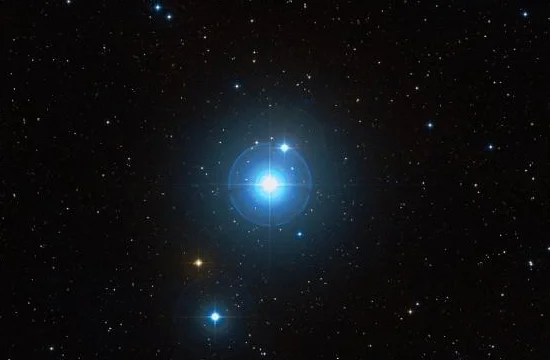
Adhafera (Zeta Leonis), image: Wikisky
Facts
Adhafera is one of the six bright stars that form the Sickle of Leo, a conspicuous asterism that outlines the head and shoulders of the celestial Lion. Other stars that form the Sickle are Regulus (Alpha Leonis), Eta Leonis, Algieba (Gamma Leonis), Rasalas (Mu Leonis), and Epsilon Leonis. The asterism appears like a backward question mark with Regulus, the 21st brightest star in the sky, sitting at the base. Regulus and Eta Leonis form the handle of the Sickle while Algieba, Adhafera and Rasalas outline the inner part of the blade, and Epsilon Leonis marks the end of the blade.
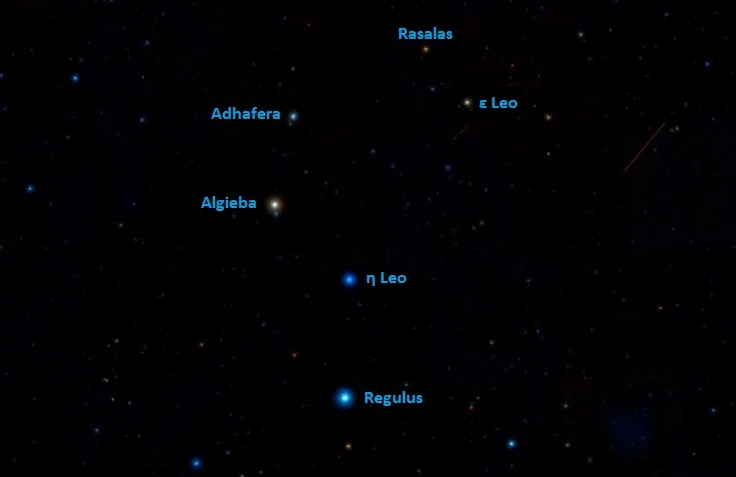
The Sickle of Leo, image: Wikisky
With an apparent magnitude of 3.33, Adhafera is the sixth brightest star in Leo. It is fainter than Regulus, Algieba, Denebola, Zosma, Epsilon Leonis, and Chertan.
Adhafera has been used as one of the stable anchor points for the Morgan-Keenan system of spectral classification since 1943. The MK system is used to classify stars based on the appearance of their spectra.
Adhafera has a visual companion, the star 35 Leonis. The two stars are not physically related, but just appear in the same line of sight when seen from Earth. 35 Leonis is a yellow (G2IV) subgiant with an apparent magnitude of 5.95. It is much closer to us than Adhafera, lying at a distance of 99 light years. The two stars are separated by 325.9 arcseconds on the sky and appear in the same field of view.
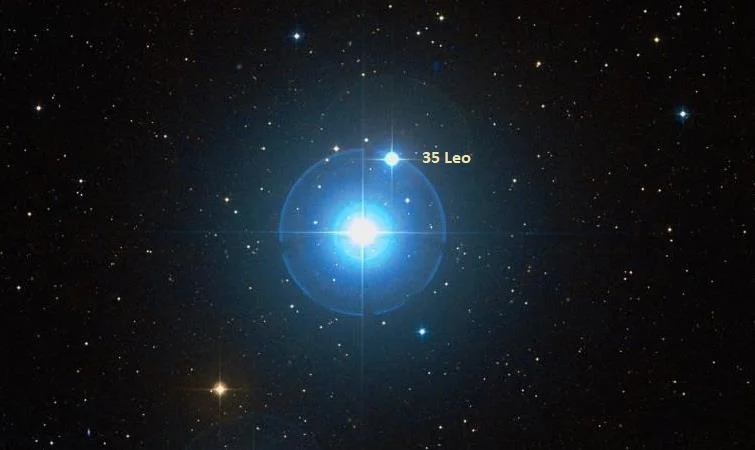
Adhafera and 35 Leonis, image: Wikisky
The radiant of the Leonid meteor shower appears just west of Adhafera and Algieba, near the centre of the Sickle. Associated with the comet Tempel-Tuttle, the Leonids peak around November 17 every year and produce meteor storms about every 33 years.
Name
The name Adhafera (pronunciation: /ædəˈfɪərə/) is derived from the Arabic aḍ-ḍafīrah, meaning “the braid” or “the curl.” It refers to the star’s position in the mane of Leo. The name was also historically spelled Aldhafera and Adhafara.
The name was approved by the International Astronomical Union’s (IAU) Working Group on Star Names (WGSN) on July 20, 2016.
In Chinese astronomy, Adhafera is known as the Eleventh Star of Xuanyuan (軒轅十一, Xuān Yuán Shí yī). Xuanjuan, the Yellow Emperor, is one of the asterisms in the Star mansion, one of the southern mansions of the Vermilion Bird. The asterism consists of 17 stars, including Regulus (Alpha Leonis), Alterf (Lambda Leonis), Epsilon Leonis, Eta Leonis, Rasalas (Mu Leonis), Algieba (Gamma Leonis), Subra (Omicron Leonis), Rho Leonis, Kappa Leonis, 10 Ursae Majoris, Alpha Lyncis, and 38 Lyncis
Location
Adhafera is easy to identify because it is one of the bright stars in the blade of the Sickle. The Sickle is quite prominent by itself, but it can be found using the stars of the Big Dipper. A line drawn from Megrez through Phecda (the inner stars of the Dipper’s bowl) leads to Regulus, the star at the base of the Sickle.
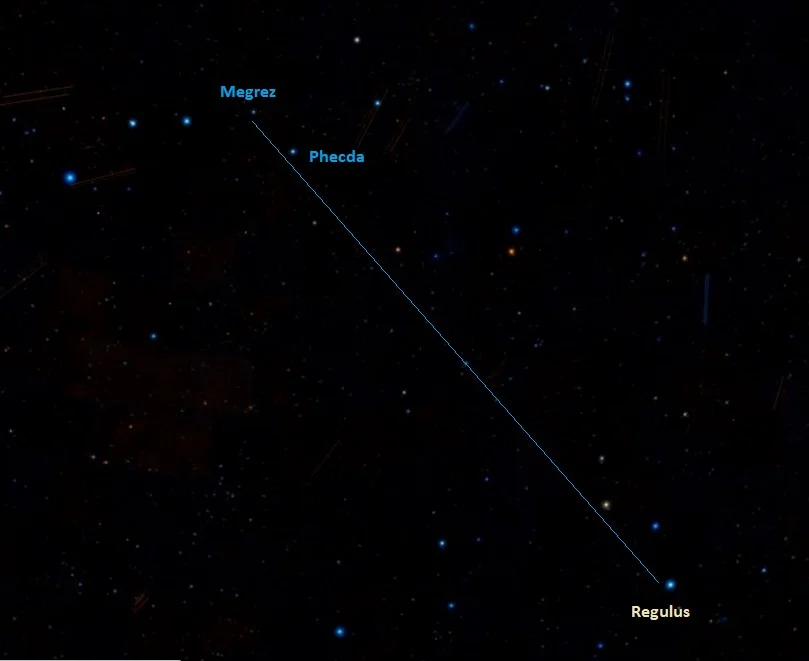
The Big Dipper and the Sickle of Leo, image: Wikisky
Adhafera is the third star in the Sickle going from Regulus.
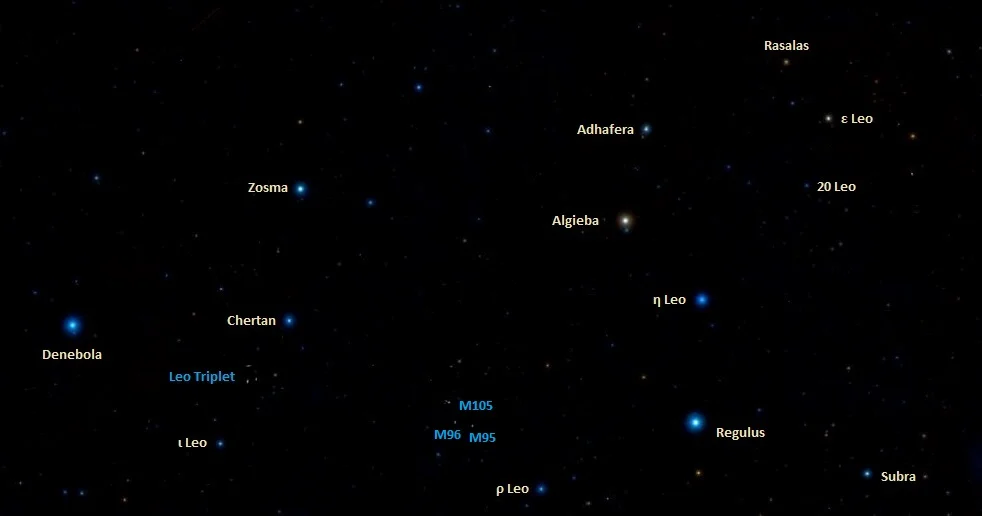
Leo stars, image: Wikisky
Adhafera and its southern neighbour Algieba can be used to find a relatively bright group of galaxies. Hickson 44 (HCG 44) is a compact group consisting of four galaxies – NGC 3185 (mag. 12.17), NGC 3187 (mag. 12.77), NGC 3190 (mag. 11.1), and NGC 3193 (mag. 10.81) – that appear about halfway between Algieba and Adhafera. The group lies approximately 80 million light years away. The brighter NGC 3193 and NGC 3190 are unbarred spiral galaxies, while NGC 3185 and NGC 3187 have a barred spiral structure. NGC 3190 hosted two supernovae observed in 2002.
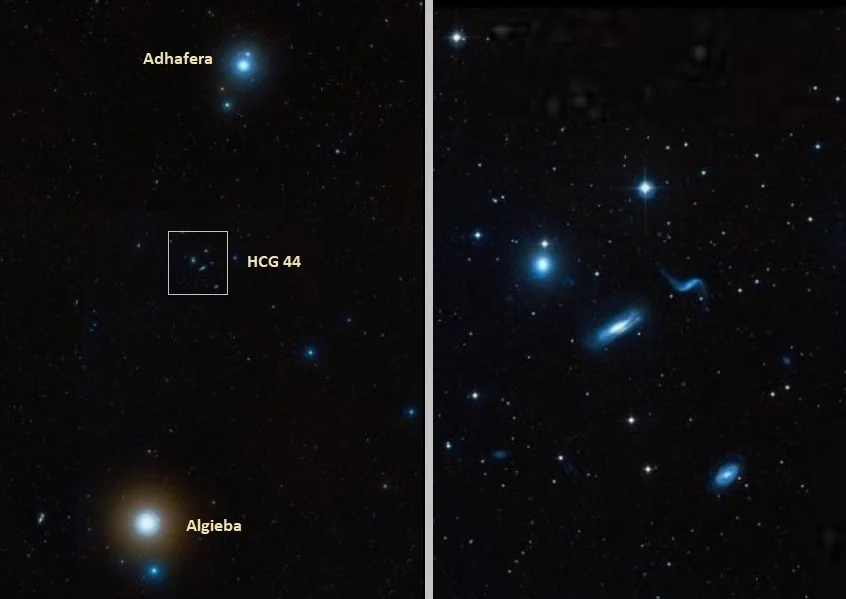
Algieba, Adhafera and Hickson 44, image: Wikisky
Constellation
Adhafera is located in the constellation Leo. Leo is the 12th largest constellation in the sky and fifth largest northern constellation, stretching across an area of 947 square degrees. Like other constellations in the zodiac family, it was first catalogued by the Greek astronomer Ptolemy in his Almagest in the 2nd century CE and is considered one of the 48 Greek constellations. It represents the Nemean lion, associated with the myth of Heracles.
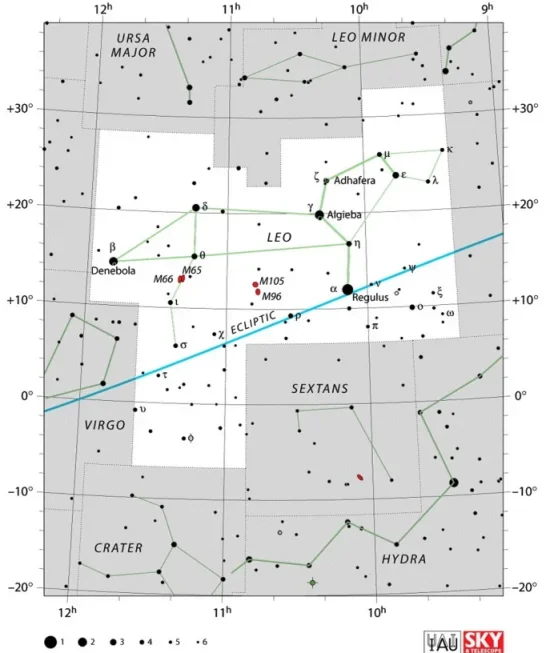
Leo constellation map by IAU and Sky&Telescope magazine
Leo is one of the few constellations that really look like the animal they represent, with the Sickle asterism outlining the lion’s mane, the bright Regulus marking the heart, and Denebola the tail.
The constellation is best known for being home to Regulus, one of the brightest stars in the sky, Denebola, a white main sequence star located 35.9 light years away, and the red dwarf Wolf 359, one of our nearest neighbours, located only 7.86 light years away. Leo is also home to the carbon star CW Leonis, the brightest star in the infrared N-band (10 μm), Icarus (MACS J1149 LS1), one of the most distant stars discovered to date, Caffau’s Star, one of the oldest known stars in the Milky Way with an estimated age of 13 billion years, the variable red giant R Leonis, and the white supergiant Eta Leonis.
Leo contains many well-known deep sky objects. These include the Leo Triplet of galaxies (Messier 65, Messier 66 and NGC 3628), the Leo I (Messier 96) Group, which includes the galaxies Messier 95, Messier 96 and Messier 105, the interacting galaxies NGC 3226 and NGC 3227, the Owl Galaxy (or Smiley Face Galaxy, NGC 3785), the Silverado Galaxy (NGC 3370), and the elliptical galaxy NGC 3842, the brightest member of the Leo Cluster of galaxies.
The constellation also contains the Cosmic Horseshoe, a gravitationally lensed system of two galaxies located 5.2 and 10.3 gigalight years away, and the preplanetary Frosty Leo Nebula.
The best time of year to watch the stars and deep sky objects in Leo is during the month of April, when the constellation is prominent in the evening sky. The entire constellation is visible from locations between the latitudes 90° N and 65° S.
The 10 brightest stars in Leo are Regulus (Alpha Leo, mag. 1.40), Algieba (Gamma Leo, mag. 2.08), Denebola (Beta Leo, mag. 2.113), Zosma (Delta Leo, mag. 2.56), Epsilon Leonis (mag. 2.98), Chertan (Theta Leo, mag. 3.324), Adhafera (Zeta Leo, mag. 3.33), Eta Leonis (mag. 3.486), Subra (Omicron Leo, mag. 3.52), and Shaomin (Rho Leo, mag. 3.9).
Adhafera – Zeta Leonis
| Spectral class | F0 III |
| Variable type | Suspected |
| U-B colour index | +0.07 |
| B-V colour index | +0.30 |
| Apparent magnitude | 3.33 |
| Absolute magnitude | -1.19 |
| Distance | 274 ± 4 light years (84 ± 1 parsecs) |
| Parallax | 11.90 ± 0.18 mas (2007 Hipparcos reduction), 13.6598 mas (2018 Gaia Data Release 2) |
| Radial velocity | -21.40 ± 0.8 km/s |
| Proper motion | RA: +18.39 ± 0.20 mas/yr (Gaia: +22.190 ± 0.902 mas/yr) |
| Dec.: -6.84 ± 0.10 mas/yr (Gaia: -6.137 ± 0.910 mas/yr) | |
| Mass | 3 M☉ |
| Luminosity | 85 L☉ (Gaia: 193.763 L☉) |
| Radius | 6 R☉ (Gaia: 11.68 R☉) |
| Temperature | 6,792 K (Gaia: 6,300 K) |
| Metallicity | -0.03 dex |
| Rotational velocity | 72.4 km/s |
| Surface gravity | 3.0 cgs |
| Constellation | Leo |
| Right ascension | 10h 16m 41.4159679s |
| Declination | +23° 25′ 02.322080″ |
| Names and designations | Adhafera, Zeta Leonis, ζ Leo, 36 Leonis, HD 89025, HR 4031, HIP 50335, SAO 81265, BD +24°2209, FK5 384, PPM 100220, GC 14107, GCRV 6478, AG+23 1076, NSV 04804, JP11 1921, PLX 2412.00, UBV 9527, IRAS 10139+2340, 2MASS J10164142+2325023, TYC 1969-1261-1, Gaia DR2 725422076533653504, WDS 10167+2325A, BDS 5368 A, CCDM J10166+2327A, IDS 10110+2356 A |